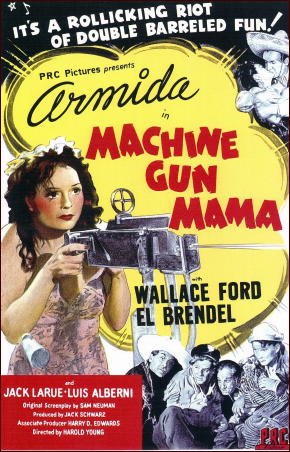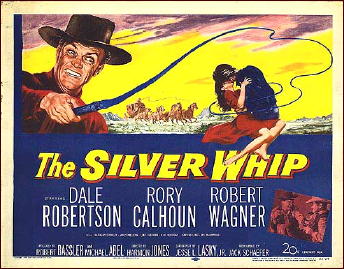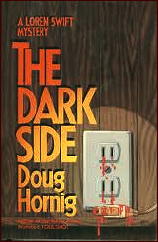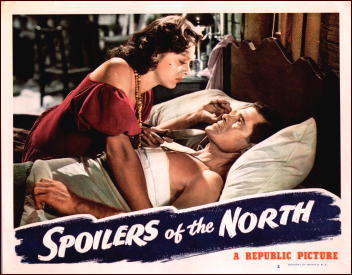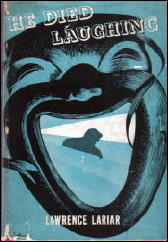April 2012
Monthly Archive
Mon 23 Apr 2012
MAKE A LIST:
TV’s Most Memorable Crime Fighters by Decade
by Michael Shonk
I tend to avoid bestseller lists and top-rated television as I have always found more enjoyment with entertainment rejected by the masses. However, today I will turn away from my reviews of one forgotten TV series after another and focus on the most remembered.
Who is each decade’s most remembered TV cop, private eye, or any other form of crime-fighter? (The category “Others” below includes not only amateur detectives, but spies, lawyers, reporters, and any other character solving crimes who is not a cop or PI.)
THE 1950s:
Cops: DRAGNET (NBC). When Jack Webb brought his popular police radio show to TV it changed television. Best remembered for its unique dialog style, the opening and closing scenes, and theme music, but it was the series’ use of close-ups and narration to speed action along that soon became standard use in television.

PI: PETER GUNN (NBC/ ABC) Created by Blake Edwards. The cool personality of Gunn (Craig Stevens) was unlike any other TV PI before. The eccentric characters that populated the stories, Mother’s jazz club with Gunn’s love interest and club singer Edie (Lola Albright) are all fondly remembered, but it was one of TV’s most famous theme songs (Henry Mancini) that made this show unforgettable.
Others: PERRY MASON (CBS) Based on characters and books by Erle Stanley Gardner, Perry remains TV’s most fondly remembered lawyer. Still popular today in syndication, who done it no longer matters; it is the interaction of the characters, Perry (Raymond Burr), Della Street (Barbara Hale), Paul Drake (William Hopper) and Hamilton Burger (William Talman) that still entertains us. The series also benefits from an unforgettable theme song.
THE 1960s:
Cops: THE UNTOUCHABLES (ABC) OK, this began in 1959, but name a more remembered and influential cop series in the 60s. Based on Eliot Ness’ memoirs (with co-writer Oscar Fraley), the series is still remembered for the protests from anti-violence and Italian-American groups. But it was the unforgettable narration of Walter Winchell, Robert Stack as Eliot Ness and its high production values that should be remembered. Among the many talented people involved with this Desilu Production was Quinn Martin who would become one of TV’s most famous producers of crime drama.
PI: MANNIX (CBS) Created by Richard Levinson and William Link, and more importantly, developed by Bruce Geller. The original premise of having old school PI Joe Mannix (Mike Conners) work at a modern computerized PI agency failed. The second season found Joe on his own as he was meant to be, with his African-American secretary Peggy (Gail Fisher), Mannix would become one of TV’s most remembered PIs series.
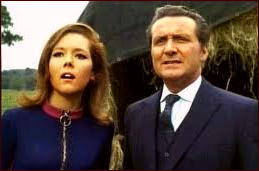
Others: THE AVENGERS (ABC) Created by Sydney Newman. This British TV series has existed in many forms, all with government agent John Steed (Patrick Macnee), but the best remembered version are the Emma Peel (Diana Rigg) years. Part of the 60s ITC British invasion of American television, the series was also noted for its surreal plots and modern fashion style of clothes. Kinky boots.
THE 1970s:
Cops: COLUMBO (NBC/ ABC) Created by Richard Levinson and William Link. The series began as part of the NBC Mystery Movie wheel series and resurfaced more than once since. Columbo (Peter Falk) is such an iconic character that his rumbled raincoat is better remembered today than most of last season’s television series.
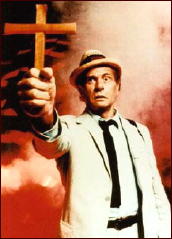
PI: CHARLIE’S ANGELS (ABC) Created by Ivan Goff and Ben Roberts. Three beautiful female PI’s work for the mysterious Charlie. The series would live on with two successful theatrical films and a failed TV remake. People still can name you their favorite Angel. (Mine’s Sabrina — Kate Jackson.). This series is remembered less as a PI show but as the perfect example of 70s TV, pretty, cheesy, mindless fun.
Others: KOLCHAK: THE NIGHT STALKER (ABC) Created by Jeff Rice and starred Darren McGavin as reporter Carl Kolchak. This is an example of how opinions of TV series can change over time. A few years ago the answer here would have been Six Million Dollar Man (ABC), but with the increase interest in supernatural fiction there has been a revival of interest in Kolchak. It would not be surprising if there are more people today aware of Kolchak: The Night Stalker than the number of people who watched it in the 70s.
THE 1980s:
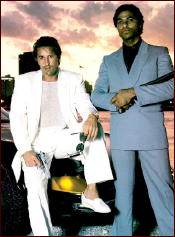
Cops: MIAMI VICE (NBC) Created by Anthony Yerkovich. Michael Mann took this TV buddy cop show with Don Johnson and Philip Michael Thomas and made it the perfect visual representation of 1980s pop culture.
PI: MAGNUM PI (CBS) Created by Donald P. Bellisario and Glen Larson. Set in Hawaii, Tom Selleck portrayed the easy going Thomas Magnum. Many today consider this series to be television’s best PI show.
Others: MURDER, SHE WROTE (CBS) Created by Richard Levinson and William Link and Peter Fischer, with Angela Landsbury as Jessica Fletcher, mystery writer and amateur detective. This series is television’s most successful attempt to create an American original traditional mystery worthy of Agatha Christie. As with many on this list it has survived cancellation with TV Movies. Currently survives in syndication and as a popular book series written by Donald Bain.
THE 1990s:

Cops: LAW AND ORDER (NBC) Created by Dick Wolf. This cop and lawyer series lasted twenty years, spawned several spin-offs and countless imitations. The famous two-note intro created by Mike Post joined the NBC chimes and Dragnet four-note opening in TV history.
PI: ROCKFORD FILES (CBS) The NBC-TV private eye series created by Stephen J. Cannell and Roy Huggins, made unforgettable by James Garner as Jim Rockford, returned to TV for a series of TV-Movies. It was a dark time for original TV PIs when the best-remembered of the decade was a remake of a PI from the 70s.
Others: X-FILES (FOX) Created by Chris Carter. This science fiction mystery featured David Duchovny and Gillian Anderson as two FBI agents solving strange crimes and dealing with a possible alien conspiracy.
THE 21st CENTURY:
Cops: CSI: CRIME SCENE INVESTIGATION (CBS) Created by Anthony E. Zucker. The series is remembered for its striking visual style, but its effect on society has gone deeper as its portrayal of forensic role in crime fighting has changed how real juries view forensic evidence such as DNA.
PI: VERONICA MARS (UPN/ CW) Created by Rob Thomas. Kristen Bell played a teenage student who got involved with her PI father’s cases. The series’ use of the season long arc story as a backdrop to weekly stand-alone episodes, as well as its school location, brought a new fresh look to the TV PI character that had been long in need of an update.
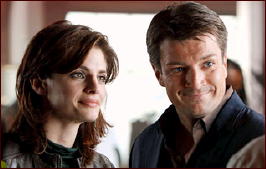
Others: CASTLE (ABC) Created by Andrew W. Marlowe. Richard Castle (Nathan Fillion) is a best selling mystery writer who tags along with Detective Kate Beckett’s team of homicide detectives. The series has such devoted fans there has been a series of “Richard Castle†Nikki Heat mystery novels published and make the NY Times bestseller list for real.
Editorial Footnote: In the first posting of this list, Michael called his third category “Amateurs.” As the discussion of his choices went along, it was generally decided that the concept of amateur detectives was too small to include all of the non-cop and non-PI series that came up for consideration. Rather than expand the number of categories, Michael has agreed to call the category “Others” instead (actually his first choice). Any crime-fighting series involving characters who are not cops or a PI now belong to this newly formulated category, as you see it now.
Mon 23 Apr 2012
GILES A. LUTZ – Relentless Gun. Gold Medal 804, paperback original; 1st printing, September 1958. Numerous later printings.
I own over 30 paperback westerns by Giles Lutz under his own name, and perhaps as many – if not more – which were published under several pen names he used, including Gene Thompson, Reese Sullivan, Hunter Ingram and Alex Hawk. (Some of these I did not know about until now, when I started looking up some information about him.)
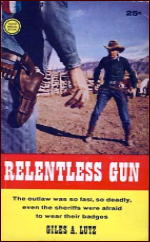
This may be the first of his “own work†that I may have read, and I enjoyed it. There is something about writing for the old pulp magazines that makes itself known right away – I can’t describe it exactly – but it has something to do with flavor and authenticity. Older western writers lived much closer to the time of the traditional western they wrote about. They grew up in it and took the life of the Old West much more for granted. Today’s western authors are excellent writers, but they’re writing about the past – a past they’re trying to recreate for readers also living in the present, far removed from the time the action of their novels is taking place.
I hope I am making some sense of this, but whether I am or not, it’s an idea I hope to return to some day, once I’ve made my thoughts on the matter more solid than they are right now. And in any case, I was right. Once I started the book, I know Lutz had to have written for the pulps, and he did. As recorded to date in the Fiction Mags Index, he seems to have written only sports stories between 1939 and 1943. The first work western pulp fiction he did that’s currently listed there is “Square in the Saddle†a short story that appeared in Street & Smith’s Western Story, July 1945.
As the pulps began to die out, Lutz turned to writing full length novels. The first of these, as far as I’ve been able to discover, was Fight or Run (Popular Library, 1954). From that point on, he was prolific enough to be worth doing a complete bibliography for, and maybe I will someday.
Whether Relentless Gun was typical of his work, I can’t presently say, but it’s the one I just read. Dave Enders is the hero in this one, a guy who works for the law but doesn’t necessarily hang around in any one spot for very long. He’s heading for Tucson at the beginning of this one, to help out the sheriff there who needs his help in tracking down Miguel Blanco, a Mexican who’s the head of a gang wreaking havoc on the town.
It turns out that the Blanco’s brother was the innocent victim of a lynching mob, and he is targeting members of the mob only for revenge – making him not entirely the total outlaw the townspeople think he is. Nor is Enders himself a man without faults. He’s a man with his own strengths and weaknesses, which he realizes, and which Lutz makes the reader realize too.
There is one other complication – well, there are several, even though the book is only 144 pages long. But the one I’ll tell you about is the presence of Kate Lykens in town, a woman Enders has loved and lost before. She’s now the singer in the bar owned by Amos Busby, a man with wealth and some power in town, and you knew before I say anything more that the two men are not destined to be friends, didn’t you?
Surprisingly enough there is some detective work to be done, and Enders is up to that job too, as well as tracking Miguel Blanco down. There is also a lot of action in the same amount of pages, and some surprisingly brutal deaths. There is also not a lot of wasted wordage; the story itself is a lean and sometimes mean one. It wasn’t the Spur Award winner for that year, nor was it probably even in the running, but it’s a solid piece of work.
Sat 21 Apr 2012
Posted by Steve under
Reviews[13] Comments
ELLERY QUEEN – The French Powder Mystery. Frederick A. Stokes, hardcover, July 1930. Pocket #71, paperback; 1st printing, August 1940; #45012, 18th printing, August 1964. (All shown.) Several other paperback editions.
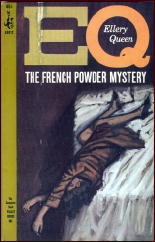
I’m sure I’ve told this story before – this blog has been going for over five years now, and it has to have come up at one time or another – but back when I first discovered Ellery Queen – I’m talking well over 50 years ago now – and was devouring them like candy after Halloween, I deliberately held one of them back.
My thinking at the time was along the lines of “If I read this last one, then I’ll have read them all, and how sad that would be, not to have any more of them to look forward to.†The book was, of course, The French Powder Mystery, and it is time, I thought to myself last Tuesday, to finally sit down and read it.
And I’m glad I did. There is the possibility that I might have enjoyed it more when I was in my teens, but enjoy it now, I most certainly did.
Compared with books written today, a lot of readers will not feel the same way. It’s not a book that has a lot of action. It has none in fact, once you exclude a failed raid on a dope house that’s totally abandoned by the time they get there.
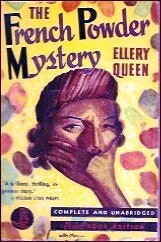
If it’s characterization you’re looking for, this early EQ novel doesn’t have a stack of that either, unless you count Ellery twirling his pince-nez glasses while deep in thought, or Inspector Queen’s reaching for his box of snuff when he feels exasperated with either the unruly nature of the case or the multitude of suspects, which is often.
It is a book that begins almost immediately with a murder, followed by 280 pages of small print completely filled with questions, answers, strange discoveries, room searches, alibis, motives, unexplained clues, secret codes and more, including several of Ellery’s discourses on deduction along the way.
There is barely room or time to take a breath. It is delightful, and (I admit) not the kind of book that is popular any more, nor will it become popular again, in my humble opinion. Readers aren’t as willing to sit and think and pay attention to details as they once they did, and boy howdy, do they ever have to in this one.
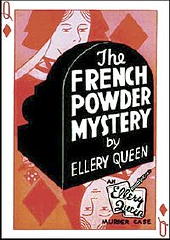
A bare outline of the plot is in order. The book begins with a body being discovered in a wall-bed that is unfolded for display in a department store window at precisely 12:15 pm. The woman is the wife of the store’s owner, who is in a high-powered business conference upstairs at the time. Missing at the same time is the man’s stepdaughter, who turns out to have several other secrets of her own, making her the chief suspect.
But there are many, many other suspects as well: store personnel, business associates, other family members and former family members. The list of characters at the beginning of the book comes in handy. And as usual in these early Ellery Queen novels, there is a page in which the author challenges the reader. “You have the facts,†you are told. “Who did it, how and why?â€
I am happy, no make that extremely pleased (without bragging) to say that, yes, I knew who did it. Not all of the details, mind you. It takes Ellery Queen the novelist the last 40 pages to go into all of them, in intricate, glorious detail.
It’s an ingenious plot, even if (I confess) a little too complicated for its own good. But I was with Ellery Queen the detective each step of the way, every small fact or clue (except maybe one) brought into the open, discussed and discarded or even better, made part of the unraveling.
Check this one off as finally finished. As I said earlier, I enjoyed myself, I did.
And now I can start over.
Sat 21 Apr 2012
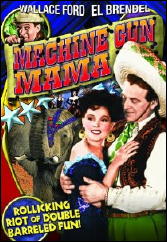
MACHINE GUN MAMA. PRC Pictures, 1944. Armida, El Brendel, Wallace Ford, Jack La Rue, Luis Alberni, Julian Rivero. Director: Harold Young.
I must have lived a sheltered life. I had never heard of El Brendel until I watched this movie. You’re never too old to learn more about the movies than you knew the day before. “El†is short for Elmer, and Brendel is pronounced “Bren-DELL.â€
He was a vaudeville star, so I’m told, whose shtick was a comically funny Swedish accent. Most of the films he made through the 1940s were comedy shorts, in which he invariably played characters named Ole, Ollie, Oley, Knute or Axel Swenson, but by the 1950s he’d worked his way up to television, including an appearance on Perry Mason, among other quite prestigious shows.
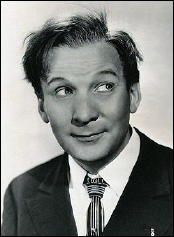
In Machine Gun Mama he’s teamed up with Wallace Ford as two guys from Brooklyn who are in Mexico trying to deliver an elephant to someone whose address they’ve apparently lost. When their truck breaks down, a carnival nearby catches their eye, and that’s where the movie begins.
Let me back up for a moment. I thought when I bought this movie that maybe I was I was buying a movie about Ma Barker and her gang. Not so. Not at all. Not for a minute. The Mexican actress named Armida plays the title character, and where the machine gun comes in is a small story in itself. As it happens, Armida, the carnival owner’s daughter, is also the girl sitting in the dunking booth. Hit the bulls-eye with a baseball, and in she goes.
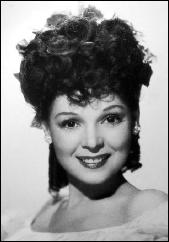
Three times in a row. All at the hands (or pitching arm) of Wallace Ford’s character. Armida, a miniature spitfire (just under five feet tall), takes offense at this, runs over to the booth opposite, turns the prop machine gun around and blasts away, destroying a lot of property but no lives, thank goodness.
She also falls in love with John O’Reilly, the famous “kibitzer†from Brooklyn (that’s Wallace Ford), but her father… Wait, wait, there’s an elephant in the room. Really. And there’s a bad guy (Jack Le Rue) to whom Armida’s father owes a lot of money to, but the elephant (really) is such a star attraction that…
I suppose that if you’re still with me, there’s a chance you’ll watch the movie, so I’ll say no more. It’s a lot of fun, not the silly, slapstick sort at all — or mostly not — but the kind of quiet fun that may make you smile a lot without ever cracking you up.
There are some songs and dance, too, but mostly (and strangely) not until the very end of the movie, which finishes up all of the story lines so quickly I had to back up the DVD to see what I’d missed. You can watch the entire 60 minutes for yourself online here on www.archive.org.
Fri 20 Apr 2012
REVIEWED BY DAN STUMPF:
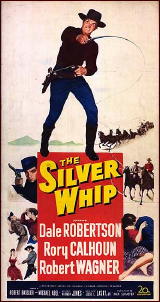
THE SILVER WHIP. 20th Century-Fox, 1953. Dale Robertson, Rory Calhoun, Robert Wagner, Kathleen Crowley, James Millican, Lola Albright. Based on the novel First Blood (1953) by Jack Schaefer. Director: Harmon Jones.
Been a mess o’ Rory Calhoun movies on lately, some pretty good. Calhoun was always the City Slicker’s idea of a Cowboy: Cool, well-groomed, morally ambiguous, often even the Heavy of the Piece, as in The Spoilers or River of No Return, but always playing his cards close to his vest in any case, his calculating eyes clearly on the Main Chance. Not a Great Actor by any stretch, but within his range quite competent and even memorable on occasion.
Later on he began doing cameos in intriguing B-flicks like Angel, Hell Comes to Frogtown, Motel Hell, and Roller Blade Warriors, all of which are better than they sound, which is faint praise, I know, but well-intended. They’re worth a look, as is:
The Silver Whip, an occasionally interesting western with Calhoun as a rough but proper Sheriff, Dale Robertson — incredibly macho-looking — as his less legal-minded but heroic buddy, and Robert Wagner as the identity-seeking youth torn between the two role models.
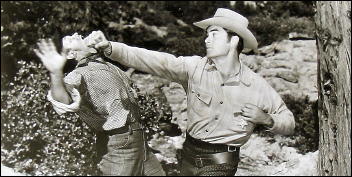
There’s a fascinating bit of action where the three heroes are stalking the heavy across the badlands, a picturesque location all by itself, with boulders, crevices, arches and cave in a baroque panoply. You’ll see one of the characters move across this arresting background, dodging from cover to cover, moving from long-shot to close-up.
Then, as he takes off, the camera stays where it is, and in the background you see one of the other heroes, previously obscured by the character in foreground, still half-hidden among the rocks, and follow him as he moves across the terrain from cover to cover, the camera tracking along and closer to him until he ends up in close-up, takes off again, and the camera stays put and in the background we see another hero, previously obscured by the character in foreground, still half-hidden etc. etc.
This goes on long enough to get really entertaining.
Coming Soon to This Blog: Several more Rory Calhoun movie reviews by Dan, including (wait for it) Hell Comes to Frogtown.
Fri 20 Apr 2012
THE ARMCHAIR REVIEWER
Allen J. Hubin
DOUG HORNIG – Deep Dive. Mysterious Press, hardcover, 1988. Popular Library, paperback, March 1989.
Doug Hornig brings back Charlottesville private eye Loren Swift for a fourth time in Deep Dive. Loren and his occasional bedmate Patricia Ryan have taken up scuba diving, and while practicing in a flooded quarry they happen upon a deceased diver.
Accidental drowning is the verdict. In due course, the dead man’s sister, having other ideas, asks Loren to investigate. Her brother, it develops, was wealthy, an experienced diver, not a particularly nice person. The quarry is on the grounds of the Jordan Institute, which does psychic research, and soon Loren is having the oddest of experiences…
Pleasant enough, though the plot takes an extra bit of believing and the ultimate solution comes out of left field.
— Reprinted from The MYSTERY FANcier,
Vol. 11, No. 1, Winter 1989.
Bibliographic Notes:
The Loren Swift series —
1. Foul Shot (1984) [Nominated for an Edgar.]
2. Hardball (1985) [Nominated for a Shamus award.]
3. The Dark Side (1986)
4. Deep Dive (1988)
Deep Dive was the final appearance of PI Loren Swift. Hornig also wrote two thriller novels with Steve Kirk as the leading character, but about him I know nothing more.
Thu 19 Apr 2012
IT’S ABOUT CRIME, by Marvin Lachman
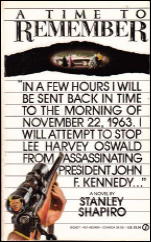
STANLEY SHAPIRO – A Time to Remember. Random House, hardcover, 1986. Signet, paperback, 1988. Made-for-TV Movie: Filmed as Running Against Time (USA Network, 1990), with Robert Hays, Catherine Hicks, Sam Wanamaker.
Coming across a [paperback] copy of Stanley Shapiro’s A Time to Remember exactly 25 years after the murder of John F. Kennedy in Dallas was too much of a coincidence to resist, and so I read another volume in the growing library on that event.
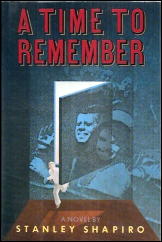
This is a science-fiction mystery in which, using time travel, a man goes back to 1963 to try to prevent Lee Harvey Oswald from shooting the President. (Shapiro does not refer to any conspiracy theories.) The science portion is not very believable, nor is the fiction much better. There are some dizzying jumps between 1963 and 1985, and much of the suspense is the result of the author causing incidents with a rather heavy hand.
Still, there are times when Shapiro writes very well, and a chase scene is described as suspensefully as the master, Cornell Woolrich, might have told it:
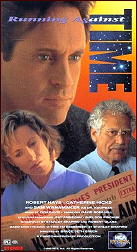
“I am filled with one overpowering, all-consuming emotion — not to get caught. Escape is what life is about. How and where is not important — only to avoid capture, to find a place to rest and think and to live on. Lungs and heart are called upon for performance levels beyond what they were created for. I know the stark terror an animal feels as it flees the advancing hunters. But that animal has trees and mountains and burrows and caves to hide in. I have only the stairs and the street below.”
The brief confrontation between a naive scientist and a Dallas prostitute on page 44 is almost, by itself, worth the price of the book. Most important, there is the endless fascination of the single most traumatic event of our time.
— Reprinted from The MYSTERY FANcier,
Vol. 11, No. 1, Winter 1989.
Editorial Comments: This is the author’s only entry in the Revised Crime Fiction IV, by Allen J. Hubin. Stanley Shapiro was far more well known as a Hollywood screenwriter: he was nominated four times for an Oscar, winning once, for Pillow Talk (1959). For a full list of his credits on IMBD, go here.
Thu 19 Apr 2012
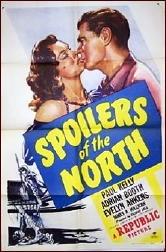
SPOILERS OF THE NORTH. Universal Pictures, 1947. Paul Kelly, Adrian Booth (Lorna Gray), Evelyn Ankers, James A. Millican, Roy Barcroft, Louis Jean Heydt. Screenplay: Milton Raison. Director: Richard Sale.
There are two good reasons for watching this movie, and neither are the two male stars. Adrian Booth is one of them. Earlier on in her career she was the actress Lorna Gray who played Vultura in the Republic serial Perils of Nyoka. The other is the slim, blonde and beautiful Evelyn Ankers, who might be recognized most by many as appearing in a couple of the Rathbone-Bruce Sherlock Holmes movies.
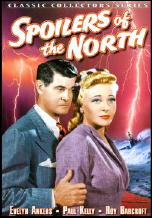
There were other substantial highlights in each of their respective careers, and respectable ones at that, but I don’t believe that either actress would have placed this film very high in their résumés. Padded with scenes of the Alaskan salmon industry, including the complete cycle of spawning, catching and the packing of the fish into small cans, without the presence of the two lovely ladies, there would be little left but the barest scraps of meat on a lot of bleached-out bones.
Paul Kelly is the nominal star of the movie, playing the kind of guy who has a girl in every port, and does. Evelyn Ankers is the one in Seattle, who comes up to help Kelly when he falls behind on the quota he’s promised his buyer. Faking an injury, Kelly needs her on hand to help persuade his brother (hunky James Millican) to not let him down and abandon ship (literally and figuratively) when the spawning season is over.
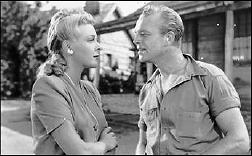
And Adrian Booth is the half-breed girl up in Alaska whom Kelly has persuaded to help keep the local Native Americans working for him – by special dispensation, they are allowed to fish salmon all year round. It’s a crooked scheme, but Kelly is up to it. Even so, not only does he have to keep the U.S. Fisheries patrol from catching on, there are the two women who can’t be allowed to discover that he’s promised to marry each of them.
And then, of course, there’s the brother, the honest one, who can’t but admire his brother’s taste in women. If you couldn’t make a small story out of these several small threads of plot, perhaps you’re not quite trying. There is one scene, though, I have to admit, that took me by surprise, and if you were ever to watch this film, it might you also.
PostScript. Yes, in case you were wondering, director Richard Sale is the same Richard Sale that started out writing tons of stories for the pulp magazines, long before he found his small niche in Hollywood as a producer, director and screenwriter (most famously for Gentlemen Marry Brunettes). The movie itself is available for watching or downloading at www.archive.org.
Photos:
Poster, upper right. Paul Kelly and Adrian Booth.
DVD, on left: Paul Kelly and Evelyn Ankers.
Black and white scene, lower right: James Millican and Evelyn Ankers.
Lobby card, above: Paul Kelly and Adrian Booth.
Wed 18 Apr 2012
Posted by Steve under
Collecting[8] Comments
When I went looking for cover images to include with Bill Deeck’s recent review of Death Paints the Picture, by Lawrence Lariar, the first thing I discovered was that there wasn’t a single copy of the Phoenix Press hardcover up for sale on Abebooks.com, not one. There were five copies of the paperback edition up for grabs, which isn’t too surprising, but the lack of hardcover copies reinforced a small realization that is obvious in many ways, but one which I’ve been slow in coming to and putting into words.
And that is, there is only a small finite number of hardcover mysteries from the 1940s that still exist, and the number that are in the hands of dealers and not already in collections is rapidly decreasing. Endangered species, is what they are.
Deciding to investigate further, I decided to look into the availability of all of Lariar’s mysteries published under his own name, the hardcover first editions only, thus excluding paperback reprints, British editions and the occasional hardcover reprint from the Detective Book Club.
I don’t know what the following data tells us, if anything. The numbers depend too greatly on a lot of different factors, none of which were controlled. I’ll have some comments after the following list. If you find any of this interesting, you can leave any insight you have as well, as usual.
Death Paints a Picture, Phoenix Press, 1943. No copies available.
He Died Laughing. Phoenix Press, 1943. Four copies, two in jacket.
The Man with the Lumpy Nose. Dodd Mead, 1944. Twelve copies, seven in jacket.
The Girl with the Frightened Eyes. Dodd Mead, 1945. Four copies, two in jacket.
Friday for Death. Crown, 1949. Two copies, two in jacket.
You Can’t Catch Me. Crown, 1951. Six copies, five in jacket.
The Day I Died. Appleton, 1952. Seven copies, five in jacket.
Win Place and Die! Appleton, 1953. Six copies, four in jacket.
I kept a record of the stated conditions, but I decided not to clutter up the presentation by including them here. Suffice it to say that they ranged from Good to Very Good, with only two (Lumpy Nose) being described as Near Fine. If you wished a complete set, price generally shouldn’t be a problem. Lariar is not a mystery writer in high demand, so even though the supply is low, the asking prices (with a few exceptions) were pretty much $20 or less.
But if the Internet did not exist (and you were not even reading this) think of the difficulty you’d have in putting a set of Lariar mystery novels together. How many bookstores would you have to travel to with want list in hand, from one end of the country to the other, to obtain them? Of course there’s slow mail, and I remember pre-Internet days of scouring fanzines for ads of various dealers who specialized in mysteries and asking for catalogs.
With a maximum of 12 copies available for any one book (Lumpy Nose), getting a set together would be a long slow process. The 1940s were 60 to 70 years ago – a lifetime in fact. The number of survivors is getting fewer and fewer.
Wed 18 Apr 2012
THE BACKWARD REVIEWER
William F. Deeck
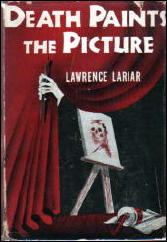
LAWRENCE LARIAR – Death Paints the Picture. Phoenix Press, hardcover, 1943. Crime Novel Selection, nn [#6], digest-sized paperback, as Death Is the Host, no date [1943].
A cartoonist himself, Lariar has as his detective Homer Bull, quite overweight and mastermind of the daily comic strip “True Stories of Crime.” Bull writes the strip while his assistant, Ham MacAndrews, does the cartooning. Ham also narrates Bull’s investigations. “‘Great jumping ginch!’ I blatted” is an example of MacAndrews’s speech which leads one to hope he draws better than he speaks.
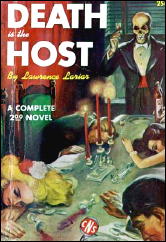
Because his man Shtunk was on a binge, Bull misses the invitation to weekend with Hugh Shipley, famed illustrator for the weekly magazines. It is an ill-assorted group that includes Bull’s ex-wife, a gossip columnist, and a tobacco mogul.
If Bull had attended, he might have been able to prevent Shipley’s alleged suicide, alleged because Bull, who shows up afterwards, is convinced Shipley was murdered, despite the room having been locked with no way for any murderer to have escaped.
Another murder made to look like suicide, though it doesn’t fool Bull, takes place before Bull figures out who and how. Probably because I have perverse tastes, I enjoyed the book.
— From The MYSTERY FANcier, Vol. 11, No. 1, Winter 1989.
BIBLIOGRAPHIC NOTES:
The Homer Bull series —
Death Paints the Picture. Phoenix Press, 1943.
He Died Laughing. Phoenix Press, 1943.
The Man with the Lumpy Nose. Dodd Mead, 1944.
The Girl with the Frightened Eyes. Dodd Mead, 1945.
Lawrence Lariar has his own page on Wikipedia. Here’s the first paragraph:
“Lawrence Lariar (December 25, 1908 – October 12, 1981) was an American novelist, cartoonist and cartoon editor, notable for his ‘Best Cartoons of the Year’ series of cartoon collections. He wrote crime novels, sometimes using the pseudonyms Michael Stark, Adam Knight and Marston la France.”
He wrote nine mystery novels under his own name; nine as Adam Knight, including eight adventures of PI Steve Conacher and one with female PI Sugar Shannon; two paperback originals as by Michael Lawrence, both cases for PI Johnny Amsterdam; and one book as by Michael Stark.
If he wrote the one mystery credited to Marston La France, it is news to Al Hubin. (Marston La France was a long-time professor and academic dean at Carleton University in Ottawa. The mystery he authored, Miami Murder-Go-Round, was copyrighted in his name. It features yet another PI, Rick Larkan.)
« Previous Page — Next Page »













